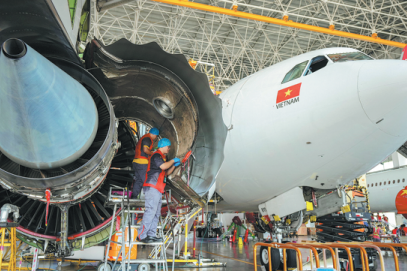Signal of intent


Blueprint of China's 15th Five-Year Plan will outline how it will enhance high-quality development and advance along the path to Chinese modernization
As societies have entered a period in which risks and challenges are synchronized and uncertainties and unpredictable factors are rising, China's policy choices within the 15th Five-Year Plan (2026-30) carry enormous consequences both internally and globally. While the final plan is expected to be unveiled in March 2026, after the National People's Congress has reviewed and approved it, the contours of this new blueprint hint at a nation seeking deeper technological self-reliance at times redefining what "high-quality development" means in a shifting geopolitical landscape. President Xi Jinping has explicitly called for new quality productive forces to play a more prominent role in the country's socioeconomic upgrading. Within this context, the 15th Five-Year Plan is critical as the country works to mindfully strengthen its foundations on all fronts by delivering resilient and inclusive future modernization progress.
As a long-standing policy framework that steers macro-policy implementation, progress in technology is the primary engine supporting China's medium- to high-speed economic growth. The framework speaks of removing local barriers, streamlining regulatory hurdles and deepening opening-up. Under mounting external pressure, China will intensify a stronger push for technological self-reliance to reduce dependence on semiconductors, artificial intelligence and other frontier technologies. In view of this, China's AI+ International Cooperation Initiative can accelerate the amalgamation of AI into key sectors to drive the "high-quality development" plan, boost the economy and modernize governance.
China is expected to extend some advanced digital technologies abroad through digital infrastructure projects, from cloud services to smart-city systems. By investing in core technologies such as AI, semiconductors and advanced manufacturing, China can move further into high-value production.
Driven by long-term strategies, the 15th Five-Year Plan is likely to tighten the mechanisms for greenhouse gas emissions monitoring and carbon footprint management, and push toward China's medium-term carbon goals. Given that the dual carbon goals of peaking carbon dioxide emissions before 2030 and achieving carbon neutrality before 2060 remain a key national policy target, it helps China meet its environmental goals while positioning China as a major player in the global clean-energy transition.
One key objective set by the Communist Party of China Central Committee in the fourth plenary session communiqué is the accomplishment of substantial improvements in "high-quality development". By upgrading traditional industries through technology and cultivating future sectors in coordination with high-technology and security, China has delivered a positive message as well as confidence in finding "opportunities amid crises" over the next five years with the solid aim of basically achieving Chinese modernization by 2035. For China itself, the 15th Five-Year Plan offers a road map for realizing high-quality development.
Accordingly, China will solidify its contribution to renewable energy, electric mobility and low-carbon technologies. For the Global South, this translates into two possible pathways. First, China can expand "Green Silk Road" cooperation, offering solar and wind infrastructure, and electric vehicle supply chains. This could accelerate energy transitions in countries that lack access to Western green finance. Second, China can introduce detailed systems for carbon footprint accounting and product certification. Driven by long-term plans, China's Belt and Road Initiative practice — making its projects "smaller, greener and smarter" — may be reflected in the 15th Five-Year Plan's international architecture.
Beyond economics, China's 15th Five-Year Plan may articulate a vision of "global development partnerships", a term that hints at a collective push to help reform multilateral governance. By aligning with the aspirations of the Global South, China is a catalyst of multipolarity, contrasting with what it frames as the West's Cold War mentality or hegemony. This could manifest in several ways. For instance, closer coordination within BRICS+, the Shanghai Cooperation Organization and other Global South-led forums; new standards and payment systems that help stabilize the global financial system; and joint positions on climate finance, technology access and trade reform in institutions such as the United Nations.
More broadly, the 15th Five-Year Plan may offer some inspirations for the European Union's goal of strategic autonomy. While China supports European strategic autonomy, Europe's likely response will be a dual strategy: controlled engagement with China on global issues, combined with defensive economic measures at home.
In this sense, China's 15th Five-Year Plan is more than an economic framework. It is a strategic declaration of how China intends to enhance high-quality development and realize its path to Chinese modernization. Moreover, any country or bloc that competes or cooperates with China must reckon with a more confident, tech-savvy and policy-coherent China. The 15th Five-Year Plan can serve as a clear reminder of how to work with China in the next five years.
Overall, the Recommendations of the Central Committee of the Communist Party of China for Formulating the 15th Five-Year Plan for National Economic and Social Development represent an extension of China's strategic resolve and policy continuity as a major global power. As the world's second-largest economy, China's long-term strategic planning contributes to global technological apparatus. The institutional edges of the 15th Five-Year Plan advance not only China from the early stages of industrialization to becoming a technological powerhouse and from rapid growth to high-quality development, but also send robust signals of new openness and cooperation levels to the international community.

The author is a former rector of the European University Cyprus, an ordinary member of the European Academy of Sciences and Arts and the director of the CASS-EUC Chinese Studies Center. The author contributed this article to China Watch, a think tank powered by China Daily.
The views do not necessarily reflect those of China Daily.
Contact the editor at editor@chinawatch.cn.


































